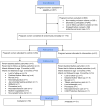Randomized Controlled Trial to Prevent Infant Overweight in a High-Risk Population
- PMID: 29277462
- PMCID: PMC5889724
- DOI: 10.1016/j.acap.2017.12.007
Randomized Controlled Trial to Prevent Infant Overweight in a High-Risk Population
Abstract
Objectives: Infants are at risk of overweight. Infant overweight predisposes child, adolescent, and adult to obesity. We hypothesized that parent education, initiated prenatally and provided in the home, would reduce the incidence of infant overweight at age 12 months.
Methods: Pregnant obese Latina women were recruited at Special Supplemental Nutrition Program for Women, Infants, and Children (WIC) and randomized to intervention versus control. Intervention subjects received home visits by trained Spanish-fluent community health workers who provided counseling on infant growth, breastfeeding, nutrition, child development, sleep, physical activity, and safety. Promotoras did not visit the control subjects. A research assistant collected outcome data on all subjects.
Results: Compared to controls, parent education did not reduce infant overweight. Infant overweight developed rapidly and was present in 46% of infants by age 6 months. Infants overweight at 6 months were likely to be overweight at age 12 months (r = 0.60, P < .0001). Overweight was more common in formula-fed infants at ages 6 months (P < .06) and 12 months (P = .005). Breastfeeding was less common in families with employed mothers (P = .02) and unemployed fathers (P < .01), but the father living with the mother at the time of the prenatal visit predicted successful breastfeeding at infant age 2 months (P < .003). Compared to formula feeding, overweight at age 12 months was 2.7 times less likely for infants breastfed for ≥2 months (P = .01).
Conclusions: The lack of success of the intervention may be explained in part by a high cesarean section rate in the intervention group, food and employment insecurity, and confounding by WIC breastfeeding promotion, which was available to all mothers. Breastfeeding was the most important mediator of infant overweight. The study supports efforts by WIC to vigorously promote breastfeeding.
Keywords: child; infant; intervention; obesity; prevention.
Copyright © 2018 Academic Pediatric Association. Published by Elsevier Inc. All rights reserved.
Conflict of interest statement
Similar articles
-
Georgia's breastfeeding promotion program for low-income women.Pediatrics. 2000 Jun;105(6):E85. doi: 10.1542/peds.105.6.e85. Pediatrics. 2000. PMID: 10835098
-
The new child food package is associated with reduced obesity risk among formula fed infants participating in the Special Supplemental Nutrition Program for Women, Infants and Children (WIC) in Los Angeles County, California, 2003-2016.Int J Behav Nutr Phys Act. 2020 Feb 10;17(1):18. doi: 10.1186/s12966-020-0921-3. Int J Behav Nutr Phys Act. 2020. PMID: 32041634 Free PMC article.
-
Influences of Parenting Education on Development of Obesity Among Young Children.Acad Pediatr. 2023 Jul;23(5):963-970. doi: 10.1016/j.acap.2023.03.010. Epub 2023 Mar 25. Acad Pediatr. 2023. PMID: 36972784 Clinical Trial.
-
Nutrition, growth, and allergic diseases among very preterm infants after hospital discharge.Dan Med J. 2013 Feb;60(2):B4588. Dan Med J. 2013. PMID: 23461996 Review.
-
Postnatal High Protein Intake Can Contribute to Accelerated Weight Gain of Infants and Increased Obesity Risk.Nestle Nutr Inst Workshop Ser. 2016;85:101-9. doi: 10.1159/000439492. Epub 2016 Apr 18. Nestle Nutr Inst Workshop Ser. 2016. PMID: 27088337 Review.
Cited by
-
Effects of the Sleep SAAF responsive parenting intervention on rapid infant weight gain: A randomized clinical trial of African American families.Appetite. 2022 Aug 1;175:106080. doi: 10.1016/j.appet.2022.106080. Epub 2022 May 13. Appetite. 2022. PMID: 35577176 Free PMC article.
-
The effectiveness of interventions during the first 1,000 days to improve energy balance-related behaviors or prevent overweight/obesity in children from socio-economically disadvantaged families of high-income countries: a systematic review.Obes Rev. 2023 Jan;24(1):e13524. doi: 10.1111/obr.13524. Epub 2022 Nov 17. Obes Rev. 2023. PMID: 36394375 Free PMC article.
-
Trends in overweight and obesity in children under 24 months of age in Mexico (2012-2020): analysis of four national health surveys.Cad Saude Publica. 2023 Dec 22;39(12):e00046123. doi: 10.1590/0102-311XEN046123. eCollection 2023. Cad Saude Publica. 2023. PMID: 38126557 Free PMC article.
-
Feasibility of a culturally adapted early childhood obesity prevention program among migrant mothers in Australia: a mixed methods evaluation.BMC Public Health. 2021 Jun 16;21(1):1159. doi: 10.1186/s12889-021-11226-5. BMC Public Health. 2021. PMID: 34134674 Free PMC article.
-
A Review of Registered Randomized Controlled Trials for the Prevention of Obesity in Infancy.Int J Environ Res Public Health. 2021 Mar 2;18(5):2444. doi: 10.3390/ijerph18052444. Int J Environ Res Public Health. 2021. PMID: 33801485 Free PMC article. Review.
References
-
- McCormick DP, Sarpong K, Jordan L, et al. Infant obesity: are we ready to make this diagnosis? J Pediatr. 2010;157:15–19. - PubMed
Publication types
MeSH terms
Grants and funding
LinkOut - more resources
Full Text Sources
Other Literature Sources


